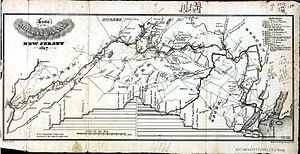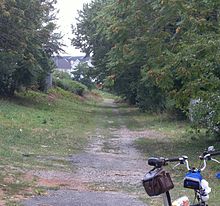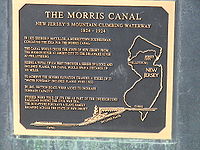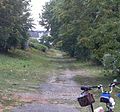- Morris Canal
-
The Morris Canal was an anthracite-carrying canal that incorporated a series of water-driven inclined planes in its course across northern New Jersey in the United States. It was in use for about a century — from the late 1820s to the 1920s.
The Morris Canal stretched from Phillipsburg on the Delaware River at its western end to Jersey City on the Hudson River at its eastern end. Completed to Newark in 1831, the canal was extended eastward to Jersey City between 1834 and 1836. It greatly facilitated the transportation of anthracite coal from Pennsylvania's Lehigh Valley to northern New Jersey's growing iron industry and other developing industries in New Jersey and the New York City area. It also carried iron ore westward through New Jersey to iron furnaces in western New Jersey and eastern Pennsylvania until the development of Great Lakes iron ore caused them to decline. By the 1850s, the canal began to be eclipsed by the construction of railroads, although it remained in heavy use throughout the 1860s. It was leased to the Lehigh Valley Railroad in 1871, taken over by the state of New Jersey late in 1922, and formally abandoned in 1924. Although it was largely dismantled in the following five years, portions of the canal and its accompanying feeders and ponds are preserved in places across northern New Jersey. It was considered a technical marvel because of its extensive use of inclined planes to overcome the large elevation changes necessary to cross the northern New Jersey hills.
Contents
Description
On the canal's western end, at Phillipsburg, a cable ferry allowed Morris Canal boats to cross the Delaware River westward to Easton, Pennsylvania, and travel up the Lehigh Canal to Mauch Chunk, in the anthracite coal regions, to receive their cargoes from the mines. From Phillipsburg, the Morris Canal ran eastward through the valley of the Musconetcong River, which it roughly paralleled upstream to its source at Lake Hopatcong, New Jersey's largest lake. From the lake the canal descended through the valley of the Rockaway River to Boonton, eventually around the northern end of Paterson's Garret Mountain, and south to its 1831 terminus at Newark on the Passaic River. From there it continued eastward across Kearny Point and through Jersey City to the Hudson River. The extension through Jersey City was at sea level and was supplied with water from the lower Hackensack River.
With its two navigable feeders, the canal was 107 mi (172 km) long. Its ascent eastward from Phillipsburg to its feeder from Lake Hopatcong was 760 ft (232 m), and the descent from there to tidewater was 914 ft (279 m). The surmounting of the height difference was considered a major engineering feat of its day, accomplished through 23 locks and 23 inclined planes. The planes were essentially short railways that allowed canal boats to be carried in open cars uphill and downhill, the plane cars being driven by a water-powered winch. The use of such devices had advantages over locks for large elevation changes in that they did not require the large amount of water needed by a "staircase" of locks and required less time to travel the vertical distance.
History
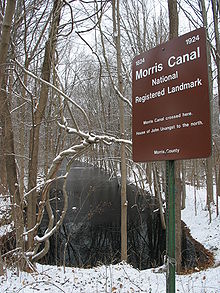 Remaining section of the Morris Canal in Montville
Remaining section of the Morris Canal in Montville
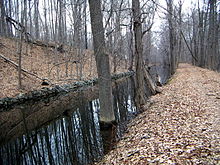 Canal today at Waterloo
Canal today at Waterloo
The idea for constructing the canal is credited to Morristown businessman George P. MacCulloch, who reportedly conceived the idea while visiting Lake Hopatcong. In 1822 MacCulloch brought together a group of interested citizens at Morristown to discuss the idea.
The Palladium of Liberty, a Morristown, New Jersey, newspaper of the day, reported on August 29, 1822: "...Membership of a committee which studied the practicality of a canal from Pennsylvania to Newark, New Jersey, consisted of two prominent citizens from each county (NJ) concerned: Hunterdon County, Nathaniel Saxton, Henry Dusenberry; Sussex County, Morris Robinson, Gamaliel Bartlett; Morris County, Lewis Condict, Mahlon Dickerson; Essex County, Gerald Rutgers, Charles Kinsey; Bergen County, John Rutherford, William Colefax...".
On November 15, 1822, the New Jersey Legislature passed an act appointing three commissioners, one of whom was Macculloch, to explore the feasibility of the project and determine the canal's possible route and an estimate of its costs. Macculloch initially greatly underestimated the height difference between the Passaic and Lake Hopatcong at only 185 ft (56 m).
On December 31, 1824, the New Jersey Legislature chartered the Morris Canal and Banking Company, a private corporation charged with the construction of the canal. The corporation issued twenty thousand shares of stock at one hundred dollars a share, providing two million dollars of capital, divided evenly between funds for building the canal and funds for banking privileges. The charter provided that New Jersey could take over the canal at the end of ninety-nine years. In the event that the state did not take over the canal, the charter would remain in effect for fifty years more, after which the canal would become the property of the state without cost. The original company failed in 1841 and was reorganized in 1844. Banking privileges were dropped in 1849, leaving the company as a canal-operating business only.
The original design of the canal allowed for boats of 25 tons, which was small by the standards of the day. By 1860, the canal had been progressively enlarged to allow for boats of 70 tons. Traffic reached a peak in 1866, when the canal carried 889,220 tons of freight (equivalent to nearly 13,000 boat loads). Between 1848 and 1860, the original overshot water wheels that powered the inclined planes were replaced with more powerful water turbines. The original iron chains used for towing the plane cars also were replaced with wire cables.
In 1871, the canal was leased by the Lehigh Valley Railroad, primarily to give that railroad the use of the valuable terminal properties at Phillipsburg and Jersey City. By 1871, however, the canal was already on the decline, and the Lehigh Valley Railroad never realized a profit from the operation of the canal. By the early 20th century, commercial traffic on the canal had become negligible. In 1922 the state of New Jersey took control of the canal and formally abandoned it in 1924; between 1924 and 1929, it was largely dismantled. The Newark City Subway, now Newark Light Rail was built along its route.
Portions of the canal are preserved in various locations around the state. Important among these is Waterloo Village, a restored canal town in Sussex County, which contains many features of the canal, including the remains of an inclined plane, a guard lock, a watered section of the canal, a canal store, and other period buildings. The Canal Society of New Jersey maintains a museum in the village.
The inlet where the canal connected to the Hudson River is now the north edge of Liberty State Park. Other remnants and artifacts of the canal can be seen along its former course. For example, on the South Kearny, NJ, peninsula, where the canal ran just south of and parallel to the Lincoln Highway, now U.S. Route 1/9 Truck, the cross-highway bridges for Central Avenue and the rail spur immediately to its east were built to span the highway and the canal,[1] resulting in spans that today seem unnecessarily long.
Images
-
Turbine at Inclined Plane 9 West in Stewartsville
-
Roebling cable on sleeper stones at Plane 9W
-
Detail of Roebling cable
-
Filled portion in Country Village, Jersey City
-
Part of the Newark City Subway runs along the route
Further reading
- Goller, Robert (1999). The Morris Canal, Across New Jersey by Water and Rail (First ed.). Arcadia Publishing. ISBN 0-7385-0076-3.
- Macasek, Joseph J. (1997). Guide to the Morris Canal in Morris County (Second ed.). Morris County Heritage Commission.
- Lee, James (1979). The Morris Canal – A Photographic History (Enlarged Revised Edition ed.). Delaware Press.
References
External links
- Canal Society of New Jersey
- Walking The Morris Canal
- Photo Documentary of the Morris Canal
- The Morris Canal in Bloomfield, NJ
- The Morris Canal in Roxbury Township, NJ
U.S. National Register of Historic Places Topics Lists by states Alabama • Alaska • Arizona • Arkansas • California • Colorado • Connecticut • Delaware • Florida • Georgia • Hawaii • Idaho • Illinois • Indiana • Iowa • Kansas • Kentucky • Louisiana • Maine • Maryland • Massachusetts • Michigan • Minnesota • Mississippi • Missouri • Montana • Nebraska • Nevada • New Hampshire • New Jersey • New Mexico • New York • North Carolina • North Dakota • Ohio • Oklahoma • Oregon • Pennsylvania • Rhode Island • South Carolina • South Dakota • Tennessee • Texas • Utah • Vermont • Virginia • Washington • West Virginia • Wisconsin • WyomingLists by territories Lists by associated states Other  Category:National Register of Historic Places •
Category:National Register of Historic Places •  Portal:National Register of Historic Places
Portal:National Register of Historic PlacesNational Register of Historic Places in Hudson County, New Jersey Historic districts Clark Thread Company Historic District | Hamilton Park Historic District | Harsimus Cove Historic District | Lembeck and Betz Eagle Brewing Company District | Paulus Hook Historic District | Van Vorst Park Historic District

Other properties Association of Exempt Firemen Building | Dr. William Barrow Mansion | Bayonne Truck House No. 1 | Bayonne Trust Company | Buildings at 1200-1206 Washington Street | Church of Our Lady of Grace | Church of the Holy Innocents | Dock Bridge | Engine Company No. 2 | Engine Company No. 3 | Engine Company No. 4 | Engine Company No. 5 | Engine Company No. 6 | Engine House No. 3, Truck No. 2 | Erie-Lackawanna Railroad Terminal at Hoboken | Fairmount Apartments | Ficken's Warehouse | Firemen's Monument | First Baptist Church | First Reformed Dutch Church of Bergen Neck | Grace Church Van Vorst | Great Atlantic and Pacific Tea Company Warehouse | Hackensack Water Company Complex | Hale-Whitney Mansion | Highland Hose No. 4 | Hoboken City Hall | Hoboken Land and Improvement Company Building | Holland Tunnel | Hudson and Manhattan Railroad Powerhouse | Hudson County Courthouse | Jefferson Trust Company | Jersey City Central Railroad Terminal | Jersey City High School | Jersey City Medical Center | Jersey City YMCA | Kestrel (steam yacht) | Keuffel and Esser Manufacturing Complex | Labor Bank Building | Monastery and Church of Saint Michael the Archangel | Morris Canal | Old Bergen Church | Pohlmann's Hall | Pulaski Skyway | Robbins Reef Light Station | St. Anthony of Padua Roman Catholic Church | St. Patrick's Parish and Buildings | Statue of Liberty National Monument, Ellis Island and Liberty Island | Edwin A. Stevens Hall | United Synagogue of Hoboken | Van Wagenen House
See also: National Register of Historic Places listings in Hudson County, New Jersey and List of National Historic Landmarks in New Jersey National Register of Historic Places in Passaic County, New Jersey Historic districts Botany Worsted Mills Historic District | Dundee Canal Industrial Historic District | Eastside Park Historic District | Great Falls of the Passaic River Historic District | Long Pond Ironworks | Paterson Downtown Commercial Historic District | Ringwood Manor

Other properties Ailsa Farms | Aycrigg Mansion | Belle Vista | Pietro and Maria Botto House | Cathedral of St. John the Baptist | Clinton Furnace | Frederick William Cooke Residence | Danforth Memorial Library | Dey Mansion | John W. Ferguson House | Goffle Brook Park | Hinchliffe Stadium | Kossuth Street School | Morris Canal | Passaic Elks Club | Paterson City Hall | Public School Number Two | John W. Rea House | Reinhardt Mills | Schuyler-Colfax House | Skylands | Reynier Speer House | St. John's Evangelical Lutheran Church | St. Michael's Roman Catholic Church | St. Nicholas Roman Catholic Church | Daniel Thompson and John Ryle Houses | U.S. Animal Quarantine Station | Van Riper-Hopper House | John and Anna Vreeland House | Westside Park (Paterson, New Jersey)
See also: National Register of Historic Places listings in Passaic County, New Jersey and List of National Historic Landmarks in New Jersey
Coordinates: 40°54′37″N 74°46′15″W / 40.910269°N 74.770717°WCategories:- 1831 establishments in the United States
- 1924 disestablishments
- Canals in New Jersey
- Canals on the National Register of Historic Places
- National Register of Historic Places in New Jersey
- Transportation in Hudson County, New Jersey
- Transportation in Morris County, New Jersey
- Transportation in Sussex County, New Jersey
- Transportation in Warren County, New Jersey
- Economic history of New Jersey
-
Wikimedia Foundation. 2010.

